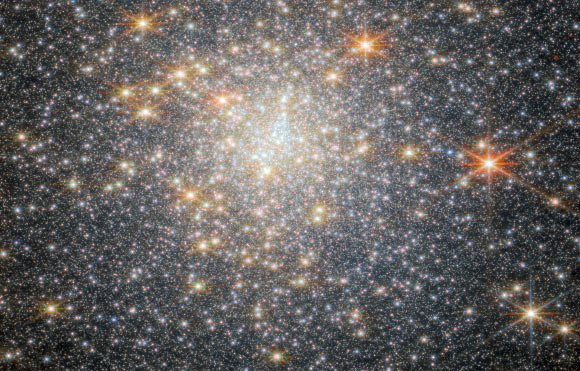NGC 6440 is a typical massive, obscured and contaminated globular cluster formed and orbiting within the bulge of our Milky Way Galaxy.

This Webb image shows NGC 6440, a globular cluster located 27,625 light-years away in the constellation of Sagittarius. Image credit: NASA / ESA / CSA / Webb / P. Freire / M. Cadelano / C. Pallanca.
NGC 6440 is located approximately 8,470 parsecs (27,625 light-years) away in the constellation of Sagittarius.
Also known as C 1746-203 or GCl 77, this globular cluster was discovered by the German-born British astronomer William Herschel on May 28, 1786.
NGC 6440 has an apparent magnitude of about 10, with a diameter of about 6 arcminutes.
“Globular clusters like NGC 6440 are roughly spherical, tightly packed, collections of old stars bound together by gravity,” said Dr. Mario Cadelano of the Universita degli Studi di Bologna and his colleagues.
“They can be found throughout galaxies, but often live on the outskirts.”
“They hold hundreds of thousands to millions of stars that are on average about one light-year apart, but they can be as close together as the size of our Solar System.”
“NGC 6440 is known to be a high-mass and metal-rich cluster that formed and is orbiting within the Galactic bulge, which is a dense, near-spherical region of old stars in the inner part of the Milky Way.”
The image of NGC 6440 was obtained with 2023 data from Webb’s Near-InfraRed Camera (NIRCam) as part of an observation program to explore the stars in the cluster and to investigate details of the cluster’s pulsars.
“A pulsar is a highly magnetized, rotating neutron star that emits a beam of electromagnetic radiation from their magnetic poles,” the astronomers said.
“To us, that beam appears as a short burst or pulse as the star rotates. Pulsars spin extremely fast.”
Astronomers have clocked the fastest pulsars at more than 716 rotations per second, but a pulsar could theoretically rotate as fast as 1,500 rotations per second before slowly losing energy or breaking apart.
“The new data indicate the first evidence from Webb observations of abundance variations of helium and oxygen in stars in a globular cluster,” the researchers said.
“These results open the window for future, in-depth investigations of other clusters in the Galactic bulge, which were previously infeasible with other telescope facilities given the significant crowding of stars in the cluster and the strong reddening caused by interstellar dust between the cluster and Earth.”
The team’s paper was published in the journal Astronomy & Astrophysics.
_____
Mario Cadelano et al. 2023. JWST uncovers helium and water abundance variations in the bulge globular cluster NGC 6440. A&A 679, L13; doi: 10.1051/0004-6361/202347961
>>> Read full article>>>
Copyright for syndicated content belongs to the linked Source : Breaking Science News – https://www.sci.news/astronomy/webb-stellar-population-ngc-6440-12902.html










